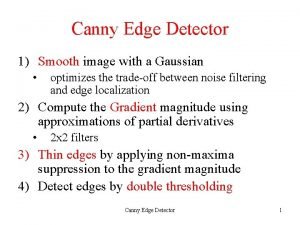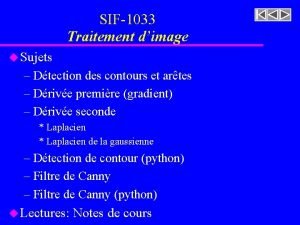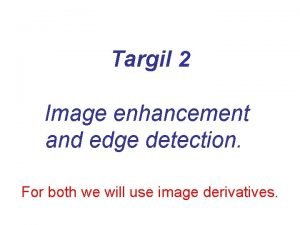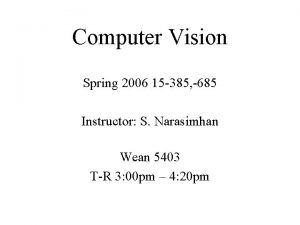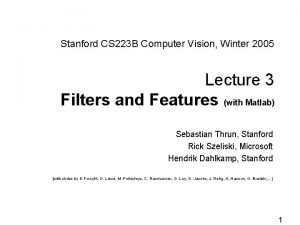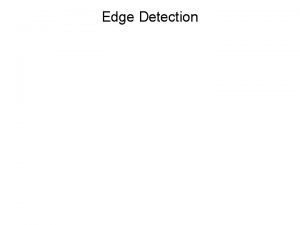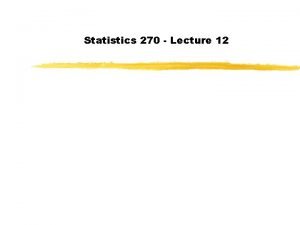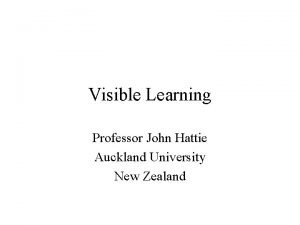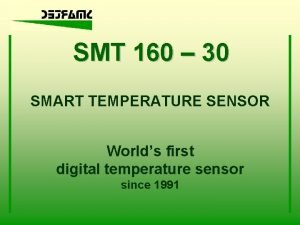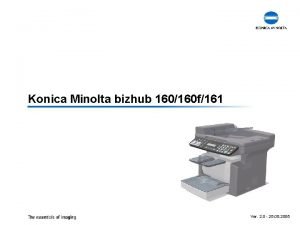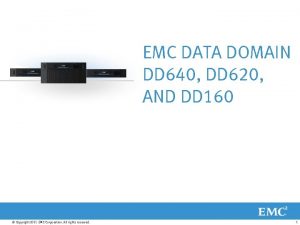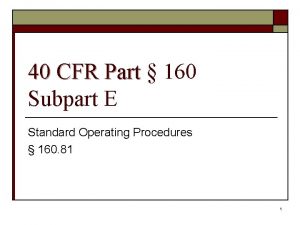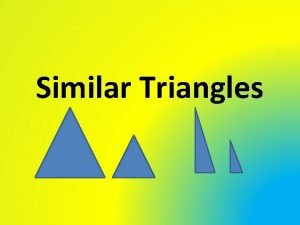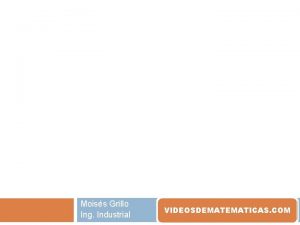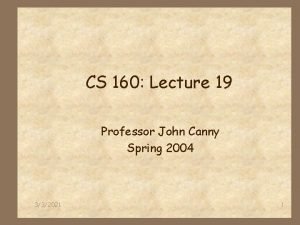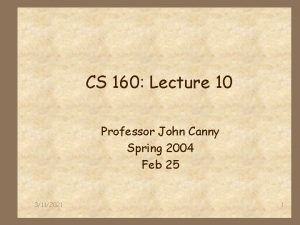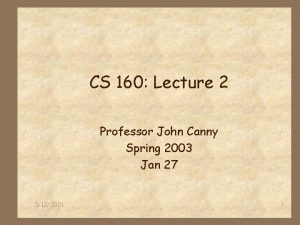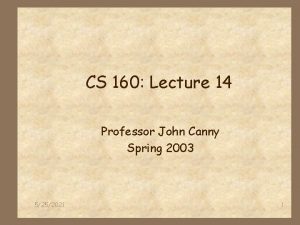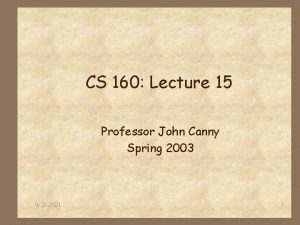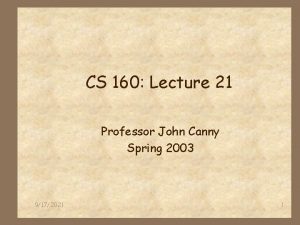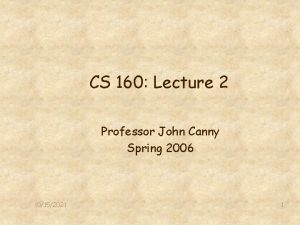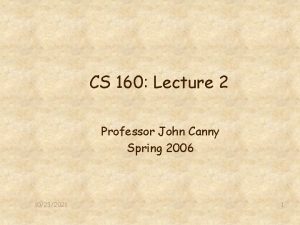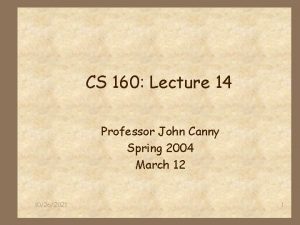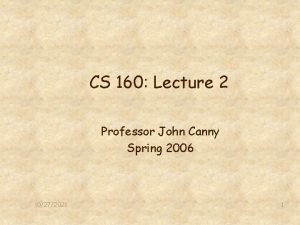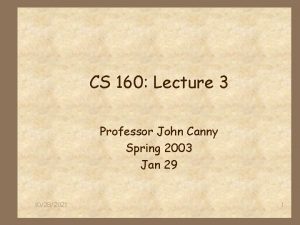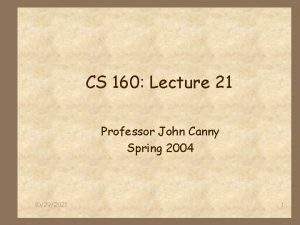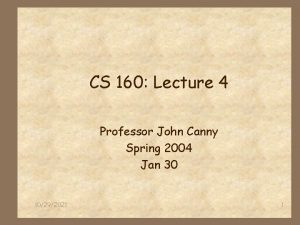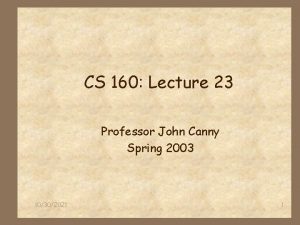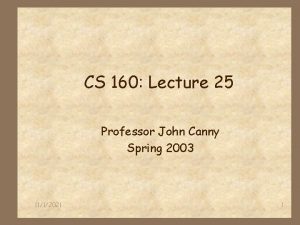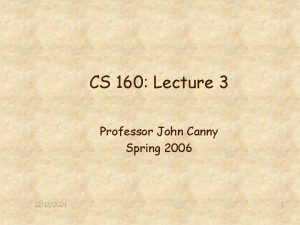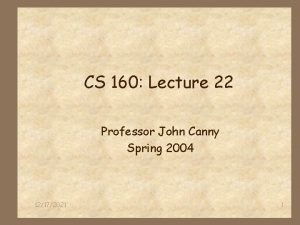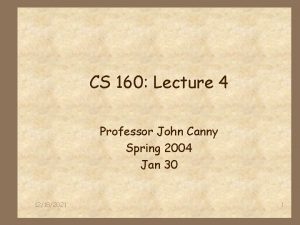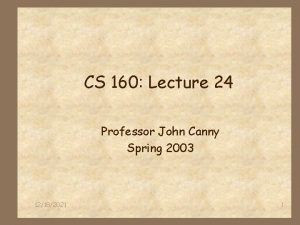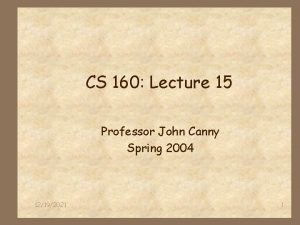CS 160 Lecture 24 Professor John Canny Spring


































- Slides: 34

CS 160: Lecture 24 Professor John Canny Spring 2003 12/7/2020 1

Preamble 4 Quiz on last lecture. 12/7/2020 2

Information Architecture 4 The OAI model (lecture 20) was our starting point for information organization. 12/7/2020 3

Information Tasks 4 Specific Fact-finding: * Find the phone number of Bill Clinton 4 Extended Fact-finding: * What kinds of music is Sony publishing? 4 Open-ended browsing: * Is there new work on voice recognition in Japan? 4 Exploration of availability: * What genealogy information is at the National Archives? 12/7/2020 4

Database queries * Query languages like SQL are widely used, but are hard to learn and easy to make mistakes with. SELECT DOCUMENT# FROM JOURNAL-DB WHERE (DATE >= 1994 AND DATE <= 1997) AND (LANGUAGE = ENGLISH OR FRENCH) AND (PUBLISHER = ASIS OR HFES OR ACM) 12/7/2020 5

Visual Query Builders 12/7/2020 6

QBE: Query By Example 4 User chooses a record (Database) or document (search engine) and specifies “more like this”. 4 User can also pick a segment of text, even a paragraph, from a good document and use it as a search query (search engines only). 12/7/2020 7

Visualizing Search Results 12/7/2020 8

Multidimensional Scaling 12/7/2020 9

Multidimensional Scaling 4 Multi-Dimensional Scaling (MDS) is a general technique for displaying n-dimensional data in 2 D. 4 It preserves the notion of “nearness”, and therefore clusters of items in n-dimensions still look like clusters on a plot. 12/7/2020 10

Multidimensional Scaling 4 MDS applied to hand-classified discussion topics. 12/7/2020 11

Multidimensional Scaling 4 Clustering of the MDS datapoints (discussion topics) 12/7/2020 12

Discussion 4 Try to assign labels to (positive and negative) X and Y axes in the previous plot. 4 Note that X and –X may not be opposites in the usual sense – * this is an artifact of linear projection methods. 12/7/2020 13

Multidimensional Scaling 4 MDS can be applied to search engine results easily because they automatically have a high -dimensional representation (used internally by the search engine). 4 The MDS plot helps organize the data into meaningful clusters. You can search either near your desired result, or scan for an overview. 12/7/2020 14

Tasks for a visualization system 1. 2. 3. 4. 5. 6. 7. Overview: Get an overview of the collection Zoom: Zoom in on items of interest Filter: Remove uninteresting items Details on demand: Select items and get details Relate: View relationships between items History: Keep a history of actions for undo, replay, refinement Extract: Make subcollections 12/7/2020 15

Visualization principles 4 To support tasks 1 & 2, a general design pattern called “focus+context” is often used. 4 Idea is to have a focal area at high resolution, but keep all of the collection at low resolution. 4 Mimics the human retina. 12/7/2020 16

Distortion 4 Several visualization systems use distortion to allow a focus+context view. 4 “Fisheye lenses” are an example of strongly enlarging the focus while keeping a lot of context (sometimes the entire dataset). 4 Many of these were developed at Xerox PARC. 12/7/2020 17

Focus+Context: Document lens 12/7/2020 18

Focus+Context: Webbook lens 12/7/2020 19

Focus+Context: Table lens 12/7/2020 20

Focus+Context: Datelens is a PDA calendar program developed at U. Maryland (Bedersen et al. ) 12/7/2020 21

Navigation: Hyperbolic trees 12/7/2020 22

Navigation: Hyperbolic trees 12/7/2020 23

Navigation: Hyperbolic trees 12/7/2020 24

Navigation: Hyperbolic trees 12/7/2020 25

Navigation: Hyperbolic trees 12/7/2020 26

Navigation: Animation 12/7/2020 27

Network visualization 4 Often use mass-spring dynamic models. 4 Can be animated and interacted with. 12/7/2020 28

Discussion 4 Animation is used in viz schemes to smooth transitions, or increase “aliveness” of the display. 4 Discuss advantages/disadvantages of animation. 12/7/2020 29

Using 3 D 4 People perceive a 3 D world from 2 D views, so it seems like we could use 3 D structure to advantage. 4 Several systems (also Xerox PARC) have tried this. 4 Use 3 D spatial memory and organization to speed up navigation. 12/7/2020 30

Web. Book 12/7/2020 31

Web Forager 12/7/2020 32

Representing Hierarchies 12/7/2020 33

Summary 4 High-dimensional data can be visualized by 2 D via Multi. Dimensional Scaling. 4 Focus+Context is a design pattern for showing the area of interest and its relationship to the entire dataset. 4 3 D techniques can leverage the spatial capabilities of the human visual system. 12/7/2020 34
 Qual tipo de filtro é o de canny?
Qual tipo de filtro é o de canny? What is canny edge detection in image processing
What is canny edge detection in image processing Filtre sobel python
Filtre sobel python Targil
Targil Joe canny
Joe canny Canny
Canny Canny
Canny Canny sebastian
Canny sebastian Edge detection
Edge detection Promotion from assistant to associate professor
Promotion from assistant to associate professor A college professor never finishes his lecture
A college professor never finishes his lecture Professor green lecture 1
Professor green lecture 1 01:640:244 lecture notes - lecture 15: plat, idah, farad
01:640:244 lecture notes - lecture 15: plat, idah, farad Spring summer fall winter and spring cast
Spring summer fall winter and spring cast Spring autumn winter summer
Spring autumn winter summer Professor john forsythe
Professor john forsythe Professor john forsythe
Professor john forsythe Professor john wood
Professor john wood Sds john holland
Sds john holland Feedback hattie effect size
Feedback hattie effect size Professor john hughes
Professor john hughes John stanley temple
John stanley temple 70 sayısının 20 eksiği kaçtır
70 sayısının 20 eksiği kaçtır Smt 160
Smt 160 12vac35-105-620
12vac35-105-620 Wac 296-800-160
Wac 296-800-160 Patrick liang
Patrick liang Konica minolta bizhub 160
Konica minolta bizhub 160 Parafrasi il canto delle sirene
Parafrasi il canto delle sirene Data domain dd620
Data domain dd620 40 cfr part 160
40 cfr part 160 Used cars mountahome ar
Used cars mountahome ar 160 5th ave new york ny 10010
160 5th ave new york ny 10010 What does similar
What does similar El exceso de un numero sobre 5
El exceso de un numero sobre 5

